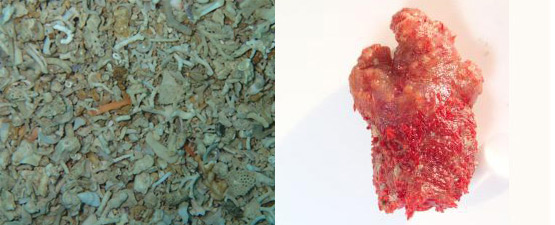Researchers' Diaries
Dr Monika Bryce
Research Scientist (Soft Corals), Western Australian Museum
This was the fourth sampling trip to the Kimberley region, providing me with yet another exciting chance to collect soft coral samples from Western Australia. This time we headed even further north than last year sampling reefs along the outer margin of the Kimberley islands and offshore at three mid-shelf sites, Echuca and Heywood Shoals and Browse Island. The trip provided an wonderful opportunity to explore for new species and gain a better understanding of the soft coral biodiversity in these remote waters. It never ceases to amaze me how much there is still left to be discovered.
My role as a research scientist for this project is to explore and comprehensively document the diversity, distribution, and abundance of the tropical octocorals. Knowledge concerning the biodiversity of the Western Australian soft coral fauna has long been neglected and very rudimentary for the Kimberley. To date I have collected some 700 specimens from this vast and pristine region. Preliminary results indicate that the west coast of Australia harbours a unique octocoral fauna, and further scientific investigation on the Kimberley’s biodiversity appears to enhance this understanding.
Thirty-one SCUBA and six intertidal stations were completed during this last field season. Each station consisted of four fifteen metre long transects, as well as opportunistic biodiversity collecting off the transect areas.
During the survey a total of 272 soft coral specimens were collected, representing all major soft corals groups - 16 families and 47 genera. In general, the collection reflects a typical Indo-Pacific assemblage for the sampled depths. Many of the soft corals are from the families Alcyoniidae and Nepththeidae, with the genera Sinularia, Sarcophyton, Dendronephthya and Chromonephthea being the most common. The suborder Holoxonia showed high species richness and abundance. Only seven species of the suborder Calcaxonia were present, but were nevertheless very abundant in most habitats. In general, species biodiversity was higher at deeper collection sites and highly dependent on habitat type.
Our first dive was at Rosella Shoals on a gently sloping sediment plain. The sediment consisted of coarse sand and shell grit (Figure 1A). It was clearly an area of high energy impact with long sediment ridges over a metre high exhibiting a distinct lack of living benthic fauna. Only a single, small specimen of the soft coral, Nephthyigorgia kückenthali was found attached to exposed limestone rock (Figure 1B).
The offshore dive sites at Browse Island, Echuca and Heywood Shoals were clearly less diverse than the inshore sites. Less than 25% of soft coral specimens were collected from these sites. These habitats were characterised by clear water, bare rock, coarse coralline sand and rubble (Figure 2A). The wave and current swept shoals appeared at first sight to be very hostile to any form of invertebrate life. Nevertheless, the small outcrops supported a rich variety of colourful benthic life (Figure 2B). Attached to the sides of some larger outcrops were colonies of the soft coral, Coelogorgia sp. and these appear to be the first record of this genus in Australia. (Figure 2 C, D). Coelogorgia is the only genus in the family Coelogorgiidae, which is represented by a single species, Coelogorgia palmosa. This species is known from the east coast of Africa to the Philippines, but further investigation is required to determine if these newly discovered colonies are the same.
Inshore habitats displayed higher abundance and diversity than the offshore sites, most likely due to the greater variety of habitats, such as crevasses, overhangs, caves, steep walls, outcrops and gutters. In current driven areas the walls of the outer slopes and gutters were covered with many sea fans (Figure 3A-D). The reef fronts were deeply incised with crevasses and caves, providing an ideal environment for soft corals, such as large groups of colourful Scleronephthya (Figure 4).
Intertidal habitats, as expected, had a low octocoral diversity. Nevertheless, the extreme high abundance of some species, such as the massive colonies of the encrusting “organ pipe coral” Tubipora sp. was amazing. These colonies were massive and covered large areas, especially on the edges of the exposed fore-reef ramps, and provide an important habitat for other invertebrates and small fish (Figure, 5 Richards et. al 2013).

- Figure 1: Rosella Shoals: 1A. Sediment consisting of shell rubble; 1B. Nephthyigorgia kükenthali (Nidaliidae).
- Photo by Monika Bryce
- Copyright Western Australian Museum.

- Figure 2: Echuca Shoal: 2A. Habitat. 2B. underside of an outcrop displaying a rich variety of colourful, benthic invertebrate life. 2C and D. Coelogorgia sp. growing on an outcrop at Echuca Shoal in the Kimberley region.
- Photo by Monika Bryce
- Copyright Western Australian Museum.

- Figure 3: Massive sea fans on walls at the fore-reef front of Freycinet Island.
- Photo by Monika Bryce
- Copyright Western Australian Museum.

- Figure 4: High soft coral biodiversity on overhangs at Freycinet Island.
- Photo by Monika Bryce
- Copyright Western Australian Museum.

- Figure 5: Massive colonies of Tubipora sp. on an intertidal reef flat, Condilac Island, Kimberley.
- Photo by Monika Bryce
- Copyright Western Australian Museum.

